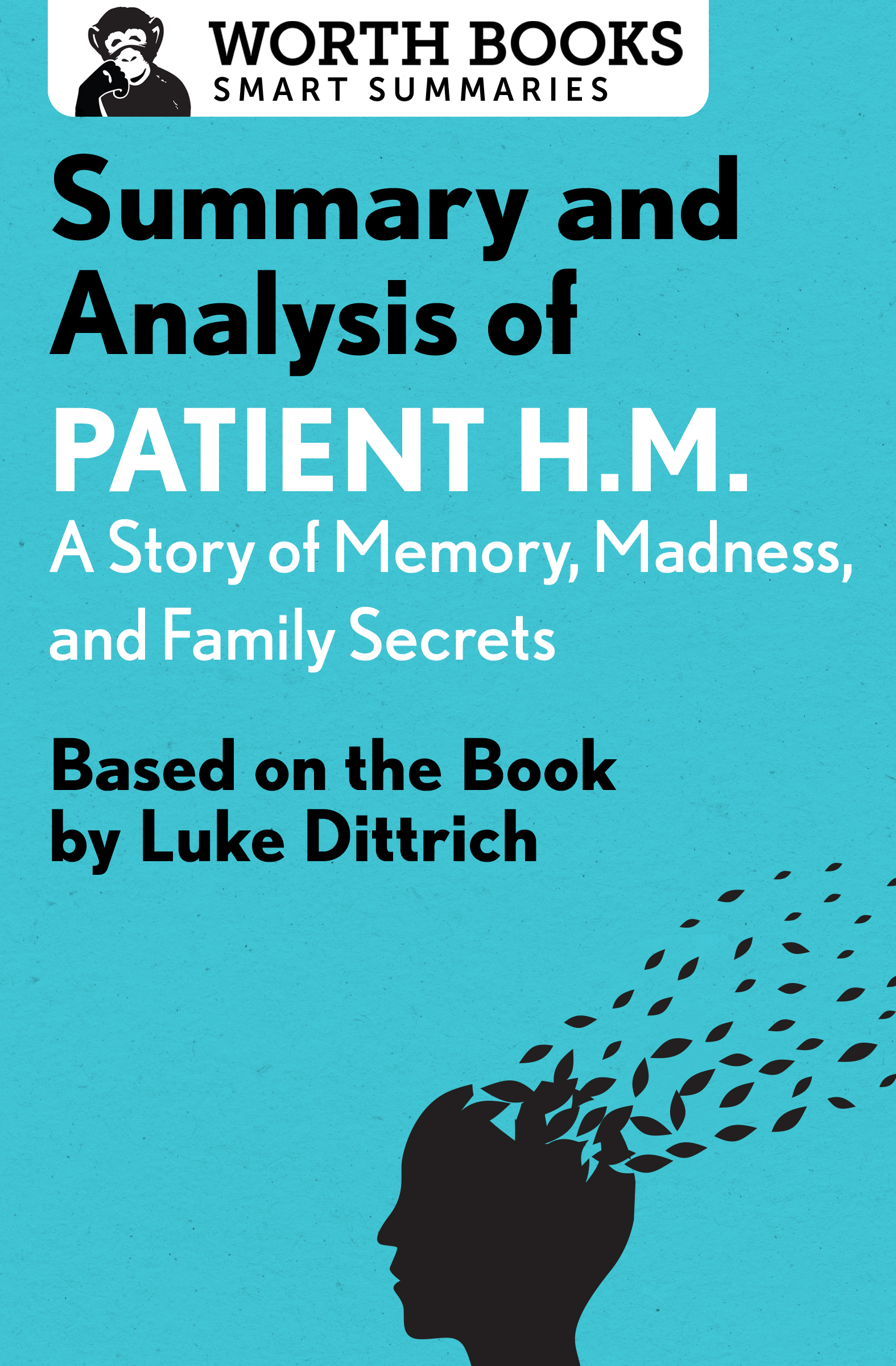Summary and Analysis of
Patient H.M.
A Story of Memory, Madness, and Family Secrets
Based on the Book by Luke Dittrich

Contents
Context
Patient H.M. joins the growing body of popular literature on the human brain, a topic that has produced bestsellers such as Daniel Golemans Emotional Intelligence and The Man Who Mistook His Wife for a Hat , by the late Oliver Sacks. But while these books presented scientific research on the brain in a manner accessible to the general public, Patient H.M. relates, in journalistic style, the story of one groundbreaking case of brain research and the cost to the human subject involved.
Published in August 2016 to qualified critical acclaim, Patient H.M. has sparked controversy over its portrayal of one of the principal characters, Dr. Suzanne Corkin (see the Need to Know section in Chapter 31). The book has also prompted a few recurring criticisms; although it is a book about science, it contains no footnotes and no references. And while it is partly a personal memoir, the narrative regularly veers off into anecdotes about the author that are not essential to the story.
Nonetheless, the story itself is fascinating, the writing is engaging, and the science is presented in a clear and understandable fashion. As it slowly unravels a family secret, Patient H.M. describes some of the brains mysteries and questions the ethics of the researchers who study them, all of which make it a captivating and troubling read.
Overview
Whenever a journalist inserts him or herself into a story, the ground underfoot immediately becomes unsteady. If the story involves the journalists family, it can easily turn to quicksand, as accuracy and objectivity can cede to the temptation to minimize embarrassing details or magnify others.
In Patient H.M.: A Story of Memory, Madness, and Family Secrets , Luke Dittrich deftly treads this uncertain terrain, combining family history, investigative reporting, and his own personal journey to obtain a fascinating, unsettling story about a most elusive scientific topic: the human memory.
The victim and hero of this tale is Henry Molaison, Patient H.M., who suffered from years of severe epilepsy after a major childhood bicycle accident. In 1953, at age twenty-seven, Molaison underwent a lobotomy that was meant to cure his epilepsy but instead left him with a nearly complete loss of short-term memory. Henrys condition made him the most studied human subject in history, interviewed repeatedly over the next five decades by psychologists and neurologists eager to unravel the mysteries of memory by examining a man who had almost none.
The operation was performed by the authors grandfather, Dr. William Scoville, a brilliant but reckless neurosurgeon who was a proponent and avid practitioner of lobotomies. Scovilles wife, Emily, suffered a psychotic episode in 1944 and was institutionalized several times at the hospital where her husband was a consulting surgeon. Dittrich tells us, somewhat pointedly, that his recollection of his grandmother as a passive, timid elderly lady did not square with the familys anecdotes about her as a vivacious, adventurous young woman.
It isnt difficult to see where this part of the story is headed. But Patient H.M. is about Henry Molaison, and how his injured brain provided much of what is known today about the way human memory functions. Dittrich reviles the scientific communitys shabby treatment of its prize patient, an only child from a working-class family who was never compensated for the many hours he spent in laboratories, and whose severed brain was ultimately dissected in a real-time event witnessed by hundreds of thousands of people around the world via the Internet.
Unfolding like a slow-moving thriller, Patient H.M. provides a big-picture look at the history of brain surgery and the study of memory. It delves into great and often gory detail about the lobotomy itself, while criticizing the ambition and cynicism of the surgeons who promoted it and eulogizing the victims left behind.
As for Dr. Scoville, Dittrich is much easier on his famous grandfather. The book paints him as a loving father and a morally complex man who recognized his failures but was undeterred by them. The damage he inflicted on Henry Molaison essentially erased the person Henry was prior to the operation; however, the man that emerged, Patient H.M., provided information to scientists that would aid in the treatment of many mental illnesses in the future. Dr. Scoville himself would have no doubts about the ethics of that tradeoff; however, most of the readers of Patient H.M. probably would.
Summary
Prologue
Luke Dittrich introduces the characters who will play a central role in the book: his grandfather, the neurosurgeon Dr. William Beecher Scoville; Henry Molaison, later to become Patient H.M.; neuroanatomist Jacopo Annese, who dissected Patient H.M.s brain; and the author himself.
Need to Know: Dittrich lets the reader know the book is both a true story and a treatise on memory, that essential but largely unknown function of the human brain.
PART I: ORIGINS
One: The Fall
As a young boy in Connecticut, Henry Gustave Molaison was hit by a bicycle, causing a brain injury that led to his epilepsy, a disease that has been studied by physicians since the time of Hippocrates. Henry, who suffered epileptic seizures and, later, long-term memory loss, would become the most studied patient in the history of neuroscience. However, his identity was kept a well-guarded secret, both by the surgeon who operated on him, Dr. Scoville, and the researcher who later studied him, Dr. Suzanne Corkin.
Need to Know: This chapter relates the beginning of Henry Molaisons journey from accident victim to epilepsy patient to prized scientific specimen. It also reproduces, in dialogue form, some of Henrys interviews with researchers, giving an idea of how fragmented and incomplete his memory was.
Two: Crumpled Lead and Rippled Copper
At his Connecticut home, Dr. Scoville kept a collection of ancient instruments used in brain surgery, which was practiced as early as four thousand years ago by the Egyptians. Papyrus scrolls show that they treated head injurieswhich were usually sustained in battlewith a combination of religious incantations and practical medicine. Their treatment was conservative and their guiding principle was that the injuries should be dressed, but that the brain itself, even if it were exposed, should not be touched.
Need to Know: Throughout history, physicians who treated head injuries did not explore the brain itself, given their lack of knowledge about it. This did not change until the 1880s, when the first neurosurgeries were performed by Dr. Gottlieb Burckhardt in Switzerland.
Three: Dream Jobs
Henry Molaison suffered his first epileptic fit at age fifteen. The seizures became more frequent, causing him to be fired from his job at a factory. He returned to high school and graduated, but was not allowed to receive his diploma in the ceremony with the rest of the students for fear he might have an episode.
Years later, when being interviewed by researchers at the Massachusetts Institute of Technology (MIT), Henry had vague and disjointed recollections of his childhood, and of anything prior to the lobotomy that was performed on him at age twenty-seven.
Dr. Scoville, the surgeon who operated on Henry, was the son of a wealthy Philadelphia family. As a young man, he was plagued by self-doubt, a quality that clashed with the brilliant and arrogant adult he later became. William eventually overcame his uncertainties and enrolled in medical school at the University of Pennsylvania.









